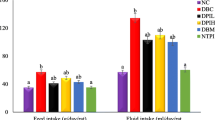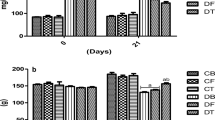Abstract
Diabetes is a chronic health problem and major cause of death in most of the countries. Diet management plays an important role in controlling diabetes and its complications along with insulin and drugs. We have examined the effect of banana (Musa sp. var. elakki bale) flower and pseudostem on hyperglycemia and advanced glycation end-products (AGEs) in streptozotocin-induced diabetic rats. Our results indicated that banana flower and pseudostem have low glycemic index and have a high content of dietary fiber and antioxidants. Diabetic symptoms like hyperglycemia, polyuria, polyphagia, polydipsia, urine sugar, and body weight were ameliorated in banana flower- and pseudostem-treated rats. Increased glomerular filtration rate in the diabetic group (5.1 ± 0.22 ml/min) was decreased in banana flower-fed (2.5 ± 0.37 ml/min) and pseudostem-fed (3.0 ± 0.45 ml/min) groups and were significant at P < 0.001 and P < 0.01, respectively. Fructosamine and AGEs formed during diabetes were inhibited in treated groups when compared with the diabetic group. The diabetic group showed 11.5 ± 0.64 μg of AGEs/mg protein in kidney, whereas, in banana flower- and pseudostem-fed groups, it was reduced to 9.21 ± 0.32 and 9.29 ± 0.24 μg/mg protein, respectively, and were significant at P < 0.01. These findings suggest that banana flower and pseudostem have anti-diabetic and anti-AGEs properties and are beneficial as food supplements for diabetics.




Similar content being viewed by others
References
Anderson JW (1986) Dietary fiber: Basic and clinical aspects. In: Vahouny GV, Kritchevsky D (eds) Plenum press, New York, pp 361–372
AOAC method 991.43 (1995) Total, insoluble and soluble dietary fiber in food-enzymatic-gravimetric method, MES-TRIS buffer. Official Methods of Analysis, 16th ed. AOAC International, Gaithersburg, MD, pp 71–72
Bandoniene D, Murkovic M, Pfannhauser W, Venskutonis PR, Gruzdiene D (2002) Detection and activity evaluation of radical scavenging compounds by using DPPH free radical and online HPLC-DPPH methods. Eur Food Res Technol 214:143–147
Baynes JW (1991) Role of oxidative stress in the development of complications in diabetes. Diabetes 40:405–412
Benzie IF, Strain JJ (1996) The ferric reducing ability of plasma (FRAP) as a measure of antioxidant power: the FRAP assay. Anal Biochem 239:70–76
Berggren AM, Bjorck IME, Nyman EMGL, Eggum BO (1993) Short chain fatty acids content and pH in caecum of rats given various sources of carbohydrates. J Sci Food Agric 63:397–406
Bieri JG, Stoewsand GS, Briggs GM, Phillips RW, Woodard JC, Knapka JJ (1997) Report of the American Institute of Nutrition Adhoc Committee on standards for nutritional studies. J Nutr 107:1340–1348
Ble-Castillo JL, Aparicio-Trápala MA, Francisco-Luria MU, Córdova-Uscanga R, Rodríguez-Hernández A, Méndez JD, Díaz-Zagoya JC (2010) Effects of native banana starch supplementation on body weight and insulin sensitivity in obese type 2 diabetics. Int J Environ Res Public Health 7:1953–1962
Bowers LD (1980) Kinetic serum creatinine assays I. The role of various factors in determining specificity. Clin Chem 26:551–554
Broadhurst CL, Polansky MM, Anderson RA (2000) Insulin like biological activity of culinary and medicinal plant aqueous extracts in vivo. J Agric Food Chem 48:849–852
Brownlee M, Vlassara H, Kooney A, Ulrich P, Cerami A (1986) Aminoguanidine prevents diabetes induced arterial wall protein cross-linking. Science 232:1629–1632
Chetankumar M, Rachappaji KS, Nandini CD, Sambaiah K, Salimath PV (2002) Modulatory effects of butyric acid - a product of dietary fiber fermentation in experimentally induced diabetic rats. J Nutr Biochem 13:522–527
Cohen MP (2003) Intervention strategies to prevent pathogenetic effects of glycated albumin. Arch Biochem Biophys 419:25–30
Ellis EN, Good BH (1991) Prevention of glomerular basement membrane thickening by aminoguanidine in experimental diabetes mellitus. Metabolism 40:1016–1019
Englyst KN, Englyst HN, Hudson GJ, Cole TJ, Cummings JH (1999) Rapidly available glucose in foods: an in vitro measurement that reflects the glycemic response. Am J Clin Nutr 69:448–454
Engvall E (1980) Enzyme immunoassay ELISA and EMIT. Methods Enzymol 70:419–439
Feillet-Coudray C, Rock E, Coudray C, Grzelkowska K, Azais-Braesco V, Dardevet D, Mazur A (1999) Lipid peroxidation and antioxidant status in experimental diabetes. Clin Chim Acta 284:31–43
Forbes JM, Cooper ME, Oldfield MD, Thomas MC (2003) Role of advanced glycation end products in diabetic nephropathy. J Am Soc Nephrol 14:S254–S258
Gao X, Ohlander M, Jeppsson N, Bjork L, Trajkovski V (2000) Changes in antioxidant effects and their relationship to phytonutrients in fruits of sea buckthorn (Hippophae rhamnoides L.) during maturation. J Agric Food Chem 48:1485–1490
Giugliano D, Ceriello A, Paolisso G (1996) Oxidative stress and diabetic vascular complications. Diabetes Care 19:257–267
Grabley S, Thiericke R (1999) In: Grabley S, Thiericke R (eds) Drug discovery from nature. Springer, Berlin, pp 3–33
Hugget ASG, Nixon DA (1957) Use of glucose oxidase, peroxidase and O- dianisidine in the determination of blood glucose and urinary glucose. Lancet 270:368–370
Ivan AR (2003) Medicinal plants of the world–chemical constituents, traditional modern medicinal uses. Totawa NJ, Humana Press Inc, pp 155–163
Joshi S (2000) Musa paradisiaca L. In: Joshi S (ed) Medicinal plants. New Oxford and IBH publishing Co. pvt Ltd, New Delhi, p 294
Kanazawa K, Sakakibara H (2000) High content of dopamine, a strong antioxidant in Cavendish banana. J Agric Food Chem 48:844–848
King H, Aubert RE, Herman WH (1998) Global burden of diabetes 1995–2025 prevalence, numerical estimates and projections. Diabetes Care 21:1414–1431
Mallick C, Maiti R, Ghosh D (2006) Anti-diabetogenic effects of separate and composite extract of seed of jamun (Eugenia jambolana) and root of kadali (Musa paradisiaca) in streptozotocin induced diabetic male albino rats: A comparative study. Int J Pharmacol 2:492–503
Mauer SM, Steffes MW, Ellis EN, Sutherland DER, Brown DM, Goetz FC (1984) Structural-functional relationships in diabetic nephropathy. J Clin Invest 74:1143–1155
Miller GL (1959) Use of dinitrosalicylic acid reagent for determination of reducing sugar. Anal Chem 31:426–428
Mokbel MS, Hashinaga F (2005) Antibacterial and antioxidant activities of banana (Musa, AAA cv. cavendish) fruit peel. Am J Biochem Biotech 1:125–131
Murugan P (2010) Tanner’s cassia (Cassia Auriculata) extract prevents hemoglobin glycation and tail tendon collagen properties in experimental diabetic rats. J Cell Tissue Res 10:2109–2114
Nilsson BO (1999) Biological effects of aminoguanidine: an update. Inflamm Res 48:509–515
Nishikimi M, Appaji N, Yagi K (1972) The occurrence of superoxide anion in the reaction of reduced phenazine methosulfate and molecular oxygen. Biochem Biophys Res Commun 46:849–854
Ojewole JA, Adewunmi CO (2003) Hypoglycemic effect of methanolic extract of Musa paradisiaca (Musaceae) green fruits in normal and diabetic mice. Methods Find Exp Clin Pharmacol 25:453–456
Pari L, Umamaheshwari J (2000) Antihyperglycemic activity of Musa sapientum flowers: effect on lipid peroxidation in alloxan diabetic rats. Phytother Res 14:136–138
Pellai N, Aashan TN (1955) Ayurveda Prakashika. S.T. Reddiar and Son, Vidyarambham Press, Quilon, pp 97–115
Pothavorn P, Kitdamrongsont K, Swangpol S, Wongniam S, Atawongsa K, Savasti J, Somana J (2010) Sap phytochemical composition of some bananas in Thailand. J Agric Food Chem 58:8782–8787
Rahbar S, Figarola JL (2003) Novel inhibitors of advanced glycation end products. Arch Biochem Biophys 419:63–79
Roger NJ (1982) Fructosamine a new approach to the estimation of serum glycosyl protein; An index of diabetic control. Clin Chim Acta 127:87–95
Somani R, Kasture S, Singhai AK (2006) Antidiabetic potential of Butea monosperma in rats. Fitoterapia 77:86–90
Suba V, Murugesan T, Rao B, Ghosh L, Pal M, Mandal SC, Saha BP (2004) Antidiabetic potential of Barleria lupulina in rats. Fitotrapia 75:1–4
Swanston-Flatt SK, Flatt PR, Day C, Bailey CJ (1991) Traditional dietary adjuncts for the treatment of diabetes mellitus. Proc Nutr Soc 50:641–651
The Diabetes Control and Complications Trial Research Group (1993) The effect of intensive treatment of diabetes on the development and progression of long-term complications in insulin-dependent diabetes mellitus. N Engl J Med 329:977–986
Thornalley PJ, Langborg A, Minhas HS (1999) Formation of glyoxal, methylglyoxal and 3-deoxyglucosone in the glycation of proteins by glucose. Biochem J 344:109–116
Trowell HC (1975) Dietary fiber hypothesis of the etiology of diabetes mellitus. Diabetes 24:762–765
Vijayakumar MV, Singh S, Chhipa RR, Bhat MK (2005) The hypoglycaemic activity of fenugreek seed extract is mediated through the stimulation of an insulin signalling pathway. Br J Pharmacol 146:41–48
Vlassara H, Palace MR (2002) Diabetes and advanced glycation end products. J Int Med 251:87–101
West IC (2000) Radicals and oxidative stress in diabetes. Diabet Med 17:171–180
Wolever TMS, Jenkins DJA (1986) Effect of dietary fiber and foods on carbohydrate metabolism. In: Spiller GA (ed) CRC Handbook of Dietary Fiber in Human Nutrition. CRC Press Inc, Florida, pp 87–119
Wuyts N, Lognay G, Sagi L, Waele DD, Swennen R (2005) Secondary metabolites in roots and implications for nematode resistance in banana (Musa spp.), International Symposium, San Jose (CRI), Nov 3–5; INIBAP: Montpellier, France, 238–246
Yamaguchi F, Ariga T, Yoshimura Y, Nakazawa H (2000) Antioxidant and anti-glycation of carcinol from Garcinia indica fruit rind. J Agric Food Chem 48:180–185
Yokozawa T, Chung HY, He LQ, Qura H (1996) Effectiveness of green tea tannin on rats with chronic renal failure. Biosci Biotechnol Biochem 60:1000–1005
Acknowledgments
The authors acknowledge the financial assistance from Council of Scientific and Industrial Research (CSIR) and the Department of Science and Technology (DST), (SR/SO/HS-OO28/2009), New Delhi, India. The authors thank Dr. V. Prakash, Director, CFTRI, for constant encouragement. Technical assistance provided by Dr. S. Mahadevamma and S. Vishwanatha is gratefully acknowledged.
Author information
Authors and Affiliations
Corresponding author
Rights and permissions
About this article
Cite this article
Bhaskar, J.J., Shobha, M.S., Sambaiah, K. et al. Beneficial effects of banana (Musa sp. var. elakki bale) flower and pseudostem on hyperglycemia and advanced glycation end-products (AGEs) in streptozotocin-induced diabetic rats. J Physiol Biochem 67, 415–425 (2011). https://doi.org/10.1007/s13105-011-0091-5
Received:
Accepted:
Published:
Issue Date:
DOI: https://doi.org/10.1007/s13105-011-0091-5




